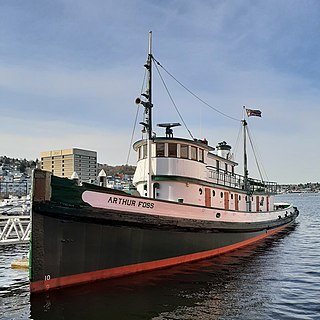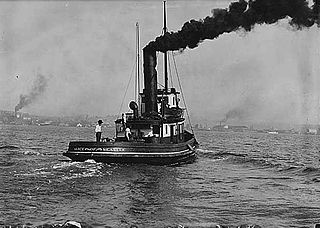
Vigor Shipyards is the current entity operating the former Todd Shipyards after its acquisition in 2011. Todd Shipyards was founded in 1916, which owned and operated shipyards on the West Coast of the United States, East Coast of the United States and the Gulf. Todd Shipyards were a major part of the Emergency Shipbuilding Program for World War II.
Thea Christiansen Foss was the founder of Foss Maritime, the largest tugboat company in the western United States. She was the real-life person on which the fictional character "Tugboat Annie" may have been very loosely based.

USS Impetuous (PYc-46) was a private yacht purchased by the Navy in August 1940 that served as a patrol boat of the United States Navy in Central America. The yacht was built as Paragon, the first of at least two Davol yachts to bear the name, in 1915 for Charles J. Davol of Providence, Rhode Island. In 1916 Davol sold the yacht to John Fred Betz, 3d of Philadelphia who renamed the yacht Sybilla III which served as the Section Patrol yacht USS Sybilla III (SP-104) from May 1917 to December 1918. Sybilla III remained in Betz's ownership until sale in 1935 to R. Livingston Sullivan of Philadelphia who renamed the yacht Arlis. On 12 August 1940 the Navy purchased the yacht placing it in commission as USS PC-454 on 16 October. The vessel was given the name Impetuous and reclassified PYc-46 on 15 July 1943. The yacht was decommissioned at Philadelphia 31 August 1944 and transferred to the War Shipping Administration for sale.
The third USS Emerald (PYC-1), was a yacht built in 1922 as Tamarack IV by the Consolidated Shipbuilding Company in Morris Heights, New York. She was acquired by the US Navy on 25 October 1940 and commissioned 27 December 1940.
USS Amethyst (PYc-3) was the yacht Samona II taken into service in the United States Navy serving as a patrol boat during World War II. After military service the vessel was returned to civilian status in 1946 and again became the yacht Samona II until sale and subsequent names of Pudlo and Explorer.

USS Aquamarine (PYc-7) was the former yacht Siele launched in April 1926 by Pusey and Jones Corporation, Wilmington, Delaware. In 1940 Siele was sold and renamed Sea Wolf which was purchased by the Navy in January 1941 and commissioned Aquamarine in April. Though given a "patrol yacht, coastal" designation the yacht was assigned to the Naval Research Laboratory for acoustical research during World War II. After naval service the yacht was again under the name Sea Wolf until sold in 1954 and renamed Miss Ann, listed on the U.S. National Register of Historic Places in 1998.
L.E."Ted" Geary was a naval architect who grew up in Seattle, Washington. He designed and raced numerous competitive sailing vessels, and also designed commuter yachts, fishing boats, tug boats, and wooden-hulled freighters.

Arthur Foss, built in 1889 as Wallowa at Portland, Oregon, is likely the oldest wooden tugboat afloat in the world. Its 79-year commercial service life began with towing sailing ships over the Columbia River bar, and ended with hauling bundled log rafts on the Strait of Juan de Fuca in 1968. Northwest Seaport now preserves the tug as a museum ship in Seattle, Washington.

HMCS Stadacona was a commissioned patrol boat of the Royal Canadian Navy (RCN) that served in the First World War and postwar until 1920. Prior to entering service with the RCN, the vessel was the private yacht Columbia. Following the war, Stadacona performed hydrographic surveys. The vessel was sold for commercial use in 1920 and was burned for salvage in 1948. Stadacona is a historic name associated with Canada, the voyages Jacques Cartier, the colony of Samuel de Champlain, and Quebec City.
Geoanna was a steel auxiliary schooner built in 1934 by Craig Shipbuilding Company in Long Beach, California. Geoanna was requisitioned during World War II for service briefly with the U.S. Navy before transfer to the U.S. Army for Southwest Pacific operations. There Geoanna served as a United States Army Signal Corps communications ship with a mixed United States Army, Navy and Australian civilian crew through the New Guinea and Philippine campaigns. The ship remained in the Philippines after post war disposal.
USS Agile (AMc-111) was an Agile-class coastal minesweeper acquired by the United States Navy for the dangerous task of removing mines from minefields laid in the water to prevent ships from passing.

The Seattle-Tacoma Shipbuilding Corporation was an American corporation which built escort carriers, destroyers, cargo ships and auxiliaries for the United States Navy and merchant marine during World War II in two yards in Puget Sound, Washington. It was the largest producer of destroyers (45) on the West Coast and the largest producer of escort carriers of various classes (56) of any United States yard active during World War II.

USS Oceanographer (AGS-3) was a survey ship of the United States Navy during World War II that produced charts chiefly of passages in the Solomon Islands area of the Pacific Ocean. Upon transfer to the Navy, she had initially briefly been named and classed as gunboat USS Natchez (PG-85). Before her World War II Navy service, she had been USC&GS Oceanographer (OSS-26), a survey ship with the U.S. Coast and Geodetic Survey from 1930.

The USS Alabaster (PYc-21) was a coastal patrol yacht of the United States Navy during World War II.
The J.M. Martinac Shipbuilding Corp. was founded in 1924 by Joseph M. Martinac on the Thea Foss Waterway in Tacoma, Washington. It specialized in the construction of tugs, trawlers, purse seiners, ferries, naval patrol craft and power yachts up to 250 feet (76 m) long.

Alice was a Puget Sound steam passenger ship built in 1897. Alice was later rebuilt into a steam tug, and later converted to diesel power and renamed Simon Foss. As a tug, the vessel was in service until 1963. This vessel should not be confused with the similarly designed vessel Alice, built in 1892, which later became Foss 18.
Velero III was a motor vessel built for George Allan Hancock at Craig Shipbuilding, Long Beach, California, with the intention of using the vessel for both business and research. Hancock was a donor to the University of Southern California with Velero III eventually becoming R/V Velero III in research associated with the university and a sculpture of the vessel appears on the Hancock Institute for Marine Studies at U.S.C. The ship was purchased for war use by the Navy on December 15, 1941 and being commissioned as the USS Chalcedony designated PYC-16 on weather duty for the Hawaiian Sea Frontier.
USS Jasper (PYc-13) was a coastal patrol yacht in the service of the United States Navy. She was named for the gemstone Jasper.
USS YP-86 was a converted fishing vessel which served as an auxiliary patrol boat in the U.S. Navy during World War II.
James Griffiths & Sons, Inc. was founded by Captain James Griffiths (1861-1943) in Seattle, Washington in 1885. James Griffiths was from Newport, England, where he was a captain of a ship. He started as an agent for NYK Line of Japan. James Griffiths ran the company with his sons: Stanley and Bert. James Griffiths & Sons, Inc. entered into a venture with the Olympic Steamship Company in 1936 to form the Consolidated Olympic Company. Consolidated Olympic Company had routes to Long Beach, California, Seattle and Tacoma, Washington, called the Olympic-Griffiths Line. The Olympic-Griffiths Line ship was the SS Olympic Pioneer was a 7,216-ton cargo ships, common freight was lumber and newsprint. Other ships operated were leased.










